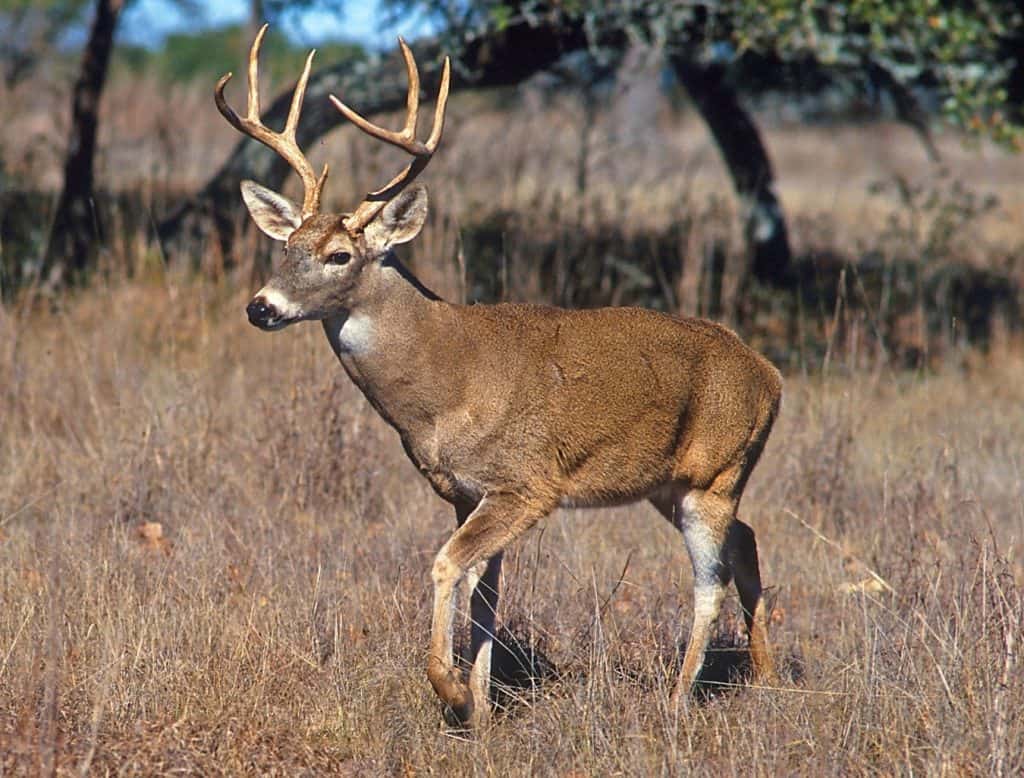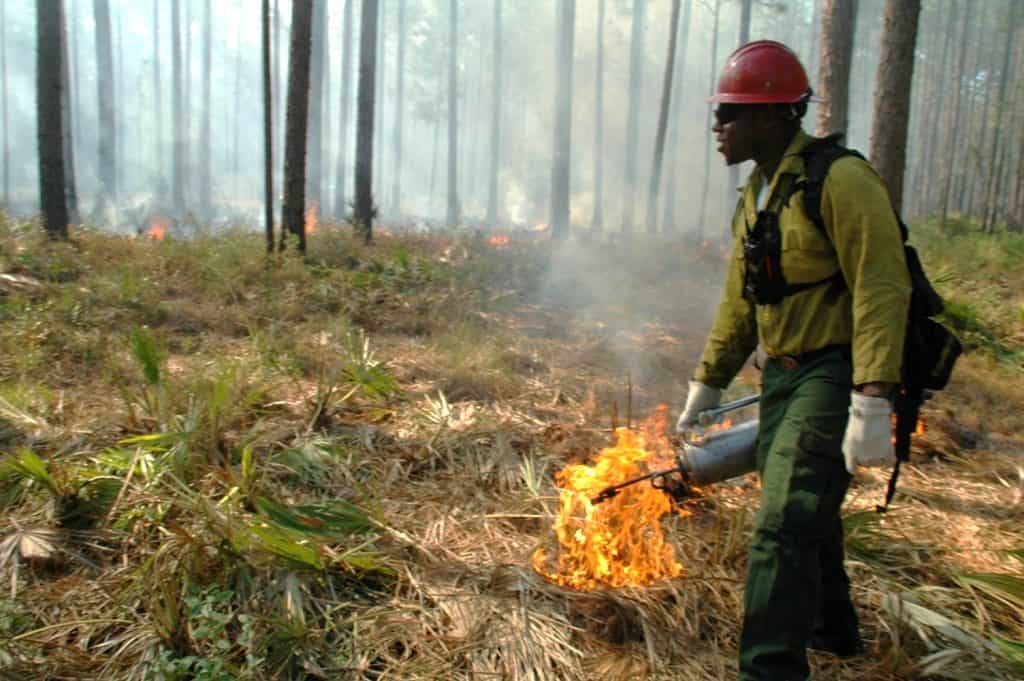Reposted from the Fire Adapted Community Learning Network Blog
I'm sure many of you are familiar with the kids' book “Going on a Bear Hunt.” The family in the book is on an adventure that takes them through rough terrain: a swirling, whirling snowstorm; a deep, dark forest; thick, oozy mud; long, wavy grass; and a narrow, gloomy cave. For readers, the suspense builds toward the cave, where a bear awaits in the darkness. But as someone who's done a lot of fieldwork, it's actually the long, wavy grass that makes my skin crawl. What about ticks?!

Credit: Modification of photo by Thomas Kohler shared via Flickr Creative Commons
On Sunday, my son and I made a site visit to a nearby burn unit. As I talked with the property manager about the burn, my toddler ran through the tall grass happily yelling “swishy swashy, swishy swashy” (a line from the book), and it got me thinking — not only about ticks, but about the interactions between ticks and prescribed fire. Ticks have been getting a fair amount of attention in the media lately, and many of the stories are saying that 2017 is going to be a particularly bad year for ticks and tick-borne illnesses. And it's not just Lyme disease that people are concerned about; ticks can cause other health complications, including an allergy to meat products (one of my favorite fire scientists actually has this!). Given the emergence of these novel complications, and the increasing incidence of tick-related diseases in general, it seems more important than ever to understand and explore the various tools we have for reducing tick populations.
To me, it seems intuitive that prescribed fire would be an effective way to impact tick populations. (Have you ever put a tick on top of a woodstove? Toasted ticks don't fare too well!) But there are ecological interactions that can complicate the effectiveness of prescribed fire for tick reduction, and treatment and study design can also have a strong influence on these types of research projects. Thus, it is no surprise that results regarding the relationship between ticks and prescribed fire have been quite variable over the years.
Most studies agree that tick populations are reduced immediately after a prescribed burn. For example, a paper by Stafford et al. (1998) showed that two spring burns in Connecticut reduced nymphal abundance of the blacklegged tick (which causes Lyme disease) by 74 and 97 percent in units with moderate and severe fire effects, respectively. However, by fall of that same year, the abundance of adult blacklegged ticks was no different in the burned areas than in the controls. Similarly, prescribed burning in tallgrass prairies in Kansas significantly reduced the abundance of the lone star tick (which is responsible for the meat allergy issue I referenced above, in addition to other diseases). However, this decline was only during the year of the burn, with no effect in units burned on longer intervals (Cully 1999). These and other papers (e.g., Drew et al. 1985) make it clear that prescribed fire affects tick populations, but results are strongly correlated with the time since burn and with the severity of the burn.
Other research demonstrates the importance of larger ecological interactions in determining post-fire tick populations. A study by Allan (2009), which took place in oak-hickory forests in the Missouri Ozarks, found that only two years after a burn, tick densities were six times higher in burned areas than in controls. In that study, improved forage in the burned areas caused disproportionate usage by white-tailed deer, which are an important carrier of the lone star tick and likely reintroduced them in high numbers to the recently burned areas.

White-tailed deer are a common carrier of ticks and can reintroduce them to recently burned areas. Credit: Scott Bauer, U.S. Department of Agriculture shared via Flickr Creative Commons
As a whole, these studies don't offer much clarity on the utility of prescribed fire for reducing tick populations — the results are so variable! But a more recent paper in PLOS ONE (Gleim et al. 2014) helps navigate and explain some of the scientific tensions in this collective body of work, and offers a more encouraging and comprehensive perspective on prescribed fire and ticks.
In this study, the authors focused on long-term prescribed burning programs in Georgia and Florida, and they accounted for a number of site conditions, including the burn regimes surrounding each study area. The study included 21 different sites across the region and involved monthly tick sampling, trail camera monitoring of tick hosts, weather measurements and vegetation surveys. In these ways, it is one of the most robust studies of tick-fire interactions to date. And the results are encouraging!

Whether or not a controlled burn reduces tick populations depends on several variables. Credit: Susan Blake, USDA Forest Service shared via Flickr Creative Commons
Gleim and her colleagues found that ticks were much more prevalent in unburned controls, and their modeling efforts showed that total tick counts were related to a number of variables, including the long-term use of burning, season, litter cover and tree density (2014). Of particular note is their finding that adjacent burn regimes (burned or unburned) had a significant effect on post-burn tick populations, both in numbers and species. This may explain some of the variance in past studies, and it highlights the importance of considering the larger landscape management context and the importance of edge effects when assessing the effectiveness of prescribed fire projects. We know this to be true in the invasive plant context (e.g., Berleman et al. 2016), but it also appears to be true for ticks.
But perhaps the most important finding in Gleim et al. is that the effective control of tick populations depends on the long-term use of prescribed fire. I appreciate this point because all too often, studies are based on a single prescribed fire treatment, even though we know that in many cases, it is the fire regime — and not just the individual burn — that we are trying to understand through our research.
In any case, I've decided that the unit my son and I visited on Sunday probably wouldn't be a great candidate for a tick-focused burn. It's only about three acres in size, probably hasn't been burned in 100 years and is surrounded by fields of tall grass. (Luckily, tick reduction is not the goal of that burn.) However, I think there is potential for a great new kids' book: “Going on a Tick Hunt,” complete with a section on the long-term benefits of prescribed fire!
References:
Allan, B. F. (2009). Influence of Prescribed Burns on the Abundance of Amblyomma americanum (Acari: Ixodidae) in the Missouri Ozarks. Journal of Medical Entomology, 46(5), 1030-1036.
Berleman, S. A., K. N. Suding, D. L. Fry, J. W. Bartolome and S. L. Stephens (2016). Prescribed Fire Effects on Population Dynamics of an Annual Grassland. Rangeland Ecology and Management, 69(6), 423-429.
Cully Jr, J. F. (1999). Lone Star Tick Abundance, Fire and Bison Grazing in Tallgrass Prairie. Journal of Range Management, 139-144.
Drew, M. L., Samuel, W. M., Lukiwski, G. M., and Willman, J. N. (1985). An Evaluation of Burning for Control of Winter Ticks, Dermacentor albipictus, in Central Alberta. Journal of Wildlife Diseases, 21(3), 313-315.
Gleim, E. R., Conner, L. M., Berghaus, R. D., Levin, M. L., Zemtsova, G. E., & Yabsley, M. J. (2014). The Phenology of Ticks and the Effects of Long-Term Prescribed Burning on Tick Population Dynamics in Southwestern Georgia and Northwestern Florida. PLOS ONE, 9(11), e112174.
Stafford III, K. C., Ward, J. S., & Magnarelli, L. A. (1998). Impact of Controlled Burns on the Abundance of Ixodes scapularis (Acari: Ixodidae). Journal of Medical Entomology, 35(4), 510-513.